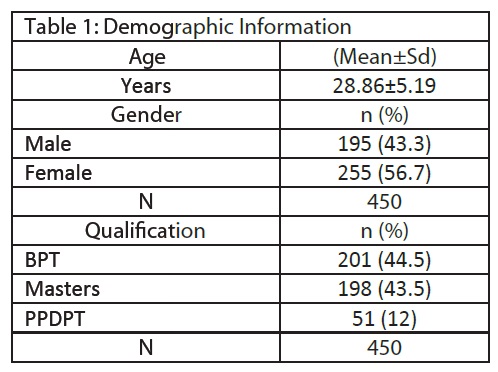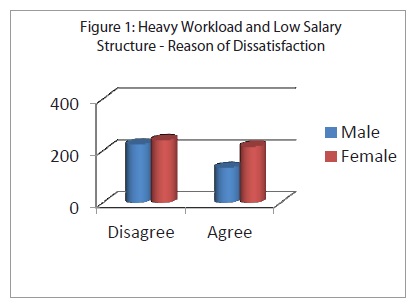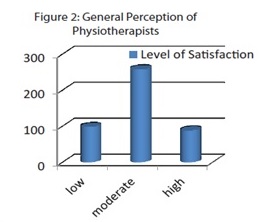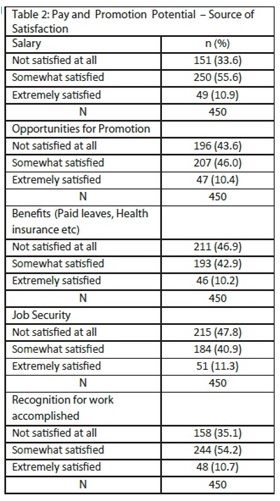ABSTRACT
OBJECTIVE
The aim of this study was to investigate the level of satisfaction among physiotherapist with regards to their profession
STUDY SETTINGS & PARTICIPANTS
A cross sectional survey was conducted. The data was collected from 450 physical therapists with recognized degrees of BPT, PPDPT, and Masters in Physical Therapy. Data was collected from 5 tertiary care hospitals, 6 clinics and privately practicing Physiotherapists in Karachi.
RESULT
The results shows that 70% physiotherapist somewhat satisfied with their general working conditions. When assessed the barriers face during the job with respect to gender it was observed that neutral responses were reported.
CONCLUSION
The finding shows that the physiotherapists are moderately satisfied with their jobs
Keywords
Job Satisfaction, Physical Therapist, General Working Condition, Pay and Promotion, Work Relationship, Skills and Abilities
Rabia Usman
Student
PP, DPT
Fariha Nafees
Student
PP, DPT
Sumaira Imran Farooqui
Principal
Ziauddin College of Physical Therapy
Ziauddin University
Nabiha Mujahid Faruq
Senior Physiotherapist
Ziauddin Hospital
[Usman R, Nafees F, Farooqui SI, Faruq NM. Level of Satisfaction of Physiotherapists with Regards to their Profession. Pak. j. rehabil. 2013;2(2):27-31]
INTRODUCTION
In recent years, physiotherapists have been increasingly interested in defining their professional identity. At the heart of this interest lies a fundamental question about the role of Physiotherapist in the field of Medicine and their standing as physiotherapy professionals. Physical medicine or physical therapy has very ancient origins. For thousands of years, people with illnesses and disabilities were treated with various methods, making use of movements (with or without the aid of mechanical devices) as well as air, water, heat and cold, electricity, and light. Despite its long history, however, astonishingly little historical research has been done on this special branch of medicine1.
Elements of physiotherapy practice can be traced to ancient China, Greece, and Rome, with significant developments occurring in Sweden and the Netherlands in the nineteenth century. Australian physiotherapy has its origins in the United Kingdom (UK) where, in 1894, an Association was formed by members of its precursor discipline—massage therapy. The growth of the profession in all other countries has very strong historical and migratory links to the UK2. The roots of the physical therapist education reach back through the ages. The profession of physical therapy may have begun as early as 3,000 BC, with evidence that the Chinese practiced massage. The development of physical therapy as an autonomous profession based on current scientific knowledge was in large part due to Per Henrik Ling of Sweden. Thereafter, physiotherapy education evolved in different ways around the world. In the UK, it was through the Society of Trained Masseuses. In Norway and Finland, it was influenced by the work of Ling, with an emphasis on massage training. In the United States, it was as a result of the polio epidemics and the need to treat those wounded during World WarI3.
As a profession integral to health promotion, prevention, acute care and rehabilitation physiotherapy plays an essential role in the health care system. It is important to explore the current nature of physiotherapy, the role of physiotherapy in health care, the practice of physiotherapy internationally, the education of physiotherapists, the regulation of physiotherapy practice and the maintenance of practice standards. It is essential for every Physiotherapist to know the depth of the profession and to understand their strengths and weaknesses for the professional growth and satisfaction4. Physiotherapist, as professionals have a general perception of their profession of being less respected or regarded in comparison to other medical and allied health care professions. It is a dilemma that despite of such a historic background and strong connection with the field of physical medicine, we have not been able to capitalize on our education and training to enhance and expand our profession nationally and internationally. Physiotherapists are constrained by a lack of clarity about their roles and scope of practice1,5.
Physiotherapy education right from the entry-level is vital in providing a base to prosper and develop. Education of students within the allied health professions aims to equip graduates with the required knowledge, skills and professional behaviors to work safely and competently as contemporary health care professionals. Broadly, clinical education involves learning clinical and professional skills in the workplace6,7. This provides students with the opportunity to actively build and incorporate theoretical and practice knowledge, to socialize into a professional practice community and to understand the complexities of health care delivery8-10. Awareness of inter-professional practice is an important graduate skill11.
Another reason that can be cause to reduce the satisfaction of physiotherapist towards their profession is the job stress which increases the risk for a variety of adverse outcomes. These outcomes include burnout, turnover, sickness absence, Work-related musculoskeletal disorders (WMSDs) and other medical conditions12-16. According to Higashiguchi, physiotherapists are invaluable assets to the hospitals and institutions where they practice. Yet the increase job turnover among physiotherapists is a reason for concern. Whether these reasons are economic or otherwise, they all give basis for seeking employment elsewhere. Increase workload leading to burnout may be another contributing factor as to why physiotherapists leave their employment17.
Journal of occupational health represents that most physiotherapists work in hospital while the other works in private clinics or rehabilitation centers. Among physiotherapist the level of job satisfaction was not known, therefore the aim of this study is to investigate the level of job satisfaction and to identify the barriers of job satisfaction among physiotherapist. If the job satisfaction level and the barriers are identified important actions can be taken into improve the level of satisfaction and consequently overcome the barriers18. There is a general perception that flexible work hours will report higher levels of organizational commitment and job satisfaction. Major advantages include lowered stress, increased job enrichment and autonomy, reduced tardiness and absenteeism, and improved job satisfaction and productivity. But at the same time the major disadvantages identified include costs, problem with scheduling and work coordination, difficulties with supervising all employees on flexible work hours, and changes in the organizational culture19. Poor salary structure is also key factor of job satisfaction therapist with low salary will not be satisfied with their profession and always be dishearten and could not perform his duties with respect on the other hand they also support their families. In physiotherapy profession there is a big gap for development and lack of opportunity for professional growth20,21. Healthcare system has remained a neglected meadow when job satisfaction is evaluated. Lesser work has been done when the discipline of physiotherapy is taken into account. Increase turnover and discontinuation of their profession among female physiotherapists is apprehensive and factors which are acting as barriers need to be evaluated. Research in this context is few and in our part of the world no appreciable work is done. Therefore, this study will be undertaken to assess the barriers leading to job dissatisfaction among physiotherapist.
MATERIALS AND METHODS
Study Design
A cross sectional survey was conducted.
Sampling Technique
A non-probability convenient sampling technique was used for data collection.
Study Setting and Participants
The data was collected from 450 physical therapists from recognized degree of physical therapy. Physiotherapist working at 5 tertiary care hospitals, 6 clinics and privately practicing physiotherapists were selected.
Study Duration
The data was collected over a period of 12 months.
Inclusion Criteria
- Physiotherapists who are qualified with recognized degree
- Physiotherapists having experience of 2 years or more.
Exclusion Criteria
- Non responsive participants.
- Physiotherapist absent at the time of data collection.
- Interns.

Data Collection Procedure
Self-administered questionnaire was used to collect data. Physiotherapists were approached at the place of their work and after explanation of the objectives of research a written consent was taken from each participant. The Questionnaire consisted of three portions corresponding to demography, barriers, and assessment of satisfaction levels. The Physiotherapist that fulfilled the inclusion criteria were asked to fill the forms. Data collected was entered and analyzed on SPSS version 20. Relevant descriptive statistics was taken out depending on the type of variable under the study. P value less than 0.05 was considered as significant.
Ethical Consideration
Informed consent will be taken from all participants after explaining them the objectives of the study. If required ERB clearance will be taken before start of data collection.
RESULTS
The level of satisfaction of physiotherapist towards their profession was assessed through a survey questionnaire. A sample of 450 physiotherapists was inducted in the study that filled the questionnaire based on their own perception and experience regarding their profession. The average age group was 28.8 ± 5.2 out of which 43.3% were males and 56.7% females. Approximately 44.5% of the respondents were Bachelors in Physical Therapy and the other 43.5% and 12% completed their masters and PPDPT respectively. For the general working condition, as it is one of the assessment tools for evaluating the level of satisfaction in this survey, we compiled four characteristics; working hours each week, flexibility in scheduling, location of work, amount of paid vacation time/sick leave offered. Among 450 individuals 72.9% people were somewhat satisfied while 17.6% were extremely satisfied with their working hours each week. When asked about the flexibility in scheduling 70.7% were somewhat satisfied and 16.4% respondents were extremely satisfied. 72.7% respondents were somewhat satisfied with their location of work. In response of 51.3% respondent, they were somewhat satisfied with their paid vacations. As shown in figure 1, most of respondents were somewhat satisfied for all four characteristics of general working condition. The reason for dissatisfaction in male and female physiotherapist was seen with respect to heavy workload and low salary structure. It has been noted that 42.6% male and 27.8% female strongly disagreed with the issue close proximity with patient while 24.6% male and 25.1% females disagreed. In response of moving heavy clients as barrier 46.7% male and 27.5% female strongly disagree, while 7.2% male and 14.5% females were strongly agreed. When ask about the poor salary structure in comparison with male and female 5.2% male and 3.9% females were strongly disagreed while 69.1% male and 59.6% females have neutral opinion about their salary structure.

When asked about pay and promotion potential 33.6% people were not satisfied at all with their salary. While 46.0% responded that they were somewhat satisfied with the opportunities for promotion. 46.9% were not satisfied at all with benefits (paid vacations, health insurance) When ask about the job security 47.8% respondents were not satisfied at all while 54.2% respondent were somewhat satisfied with work accomplishment. When physiotherapists were asked about their general perception regarding their profession, they were generally satisfied with their field. The level of satisfaction was assessed to be low, moderate or high. Among 450 participants, 22.22% of the physiotherapists had low satisfaction levels and 20% had high level of satisfaction. Interestingly, 57.77% had moderate level of satisfaction in regards.


DISCUSSION
In this survey, we assessed different dimensions of the physiotherapy profession in terms of general working conditions, pay and promotion potential, work relationships, use of skills and abilities and barriers were evaluated. Results revealed that physiotherapist have moderate level of satisfaction towards their profession. In other studies S Bodur and H Sur, concluded the global job satisfaction measured by a single item questionnaire and indicate that over 50% of the physiotherapists were dissatisfied with their job, while the characteristics of the study populations are not comparable. These findings are constant with the other studies on job satisfaction among health care providers in Turkey 22,23. A study was carried out within the framework of occupational therapy to determine the standing of physiotherapy relative to a range of professions, including a number from the medical field. The results indicate that physiotherapy possesses an intermediate status, and one that can be broadly equated with that of osteopathy: in fact, the two professions are virtually indistinguishable on most of the dimensions employed in the study. The results also reveal the position of physiotherapy relative to the nursing profession, and to that of medical practitioners24. In other studies, job stress has been linked to medical and psychiatric conditions, including depression and cardiac disease. In health care workers, job stress has been linked to reduced quality of patient care 25-27. Studies have also demonstrated that physical therapists may experience Different dimensions of work stress have been studied in physical therapists, but common themes have emerged. Common sources of work stress have included excessive workloads (both clinical and administrative) and a lack of resources (equipment, staffing, and time)28,30. The professional culture in physical therapy may complicate the work environment. Physical therapists hold themselves to high professional standards and may experience a conflict between clinical realities and personal ideals. In the face of external pressures, including increasing workloads and job demands, job stress may be viewed as a personal failing29,31,32. Grembowski D33, Bovier PA34, and Seo Y35 in their studies show that there is a strong correlation between income and job satisfaction33-35. Another study by Bodur S demonstrated in Turkey that income and working conditions were main factors for dissatisfaction for health care providers22. Our study also highlighted the fact that the opportunities for personal and professional growth were one of the best forecaster of job satisfaction. According to Japanese physical therapy association, Takeda T, and Yasuda M study observed that among the clinician with more than 15 years of working experience who work 24 to 32 hours work each week on OPD having largest number. The white paper said that the therapist who spends less than 24 hours each week could increase in number, if they have more working experience36. These differences show therapist who have more than 10 year of working experience may not feel over work because they are self-assured in their work. This research identified the expression of wishing to stay within the organization for a bright future and the perception of stability or job security as a general indicator of job satisfaction and stress. Both factors appear equally important as they were significantly related to the effort and reward imbalance of the rehabilitation staffs affected by the work load and number of patients that the therapists have to treat per day.
CONCLUSION
This study provides information about the status of general and dimensional specific job satisfaction among a group of physiotherapists who practice in Karachi, Pakistan. The finding shows that the physiotherapists were moderately satisfied with their jobs. Working conditions, promotional potentials, interpersonal relationship, salary and advancement are the best predictors of job satisfaction among physiotherapists. Specific job satisfaction dimension indicate that highest dissatisfaction levels occur in the area of salary and opportunity for professional growth.
REFERENCE
- Chipchase LS, Galley P, Jull G, McMeeken JM, Refshauge K, Nayler M, et al. Looking back at 100 years of physiotherapy education in Australia. Australian Journal of Physiotherapy 2006 Vol. 52
- Moffat, Marilyn. A History of Physical Therapist Education around the World. Journal of Physical Therapy Education 2012;26(1):13
- Terlouw TJA. Roots of Physical Medicine, Physical Therapy, and Mechanotherapy in the Netherlands in the 19th Century: A Disputed Area within the Healthcare Domain. J Man Manip Ther 2007;15(2): E23–E41.
- Higgs J, Refshauge K, Ellis E. Portrait of the physiotherapy profession. Journal of Inter-professional Care 2001;15(1):79-89
- You L, Sadler G, Majumdar S, Burnett D, Evans C. Physiotherapists’ Perceptions of Their Role in the Rehabilitation Management of Individuals with Obesity. Physiother Can 2012;64(2):168–175.
- Chipchase L, Dalton M, Williams M, Scutter S. Is education immune from evidence-based scrutiny? Aust J Physiother 2004;50(3):133-135.
- Lekkas P, Larsen T, Kumar S, Grimmer K, Nyland L, Chipchase L, et al. No model of clinical education for physiotherapy students is superior to another: a systematic review. Aust J Physiother 2007;53(1):19-28.
- Ferguson K, Edwards H. Providing clinical education: the relationship between health and education. In Educating Beginning Practitioners – Challenges for Health Professional Education. Ed: Higg J, Edwards E. Oxford: Butterworth Heinemann 1999;52-60.
- Delany C, Bragge P. A study of physiotherapy students’ and clinical educators’ perceptions of learning and teaching. Med Teach 2009;31(9):E402-E411
- Ernstzen DV, Bitzer E, Grimmer-Somers K. Physiotherapy students’ and clinical teachers’ perceptions of clinical learning opportunities: a case study. Med Teach 2009;31(3):E102-15.
- Smith M, Higgs J. (Eds) Trends in fieldwork education. Rotterdam L: Sense Publishers;2010.
- Escriba-Aguir V, Martin-Baena D, Perez-Hoyos S. Psychosocial work environment and burnout among emergency medical and nursing staff. Int Arch Occup Environ Health 2006;80:127–133.
- Ahola K, Hakanen J. Job strain, burnout, and depressive symptoms: a prospective study among dentists. J Affect Disord 2007;104(1-3):103–10.
- de Croon EM, Sluiter JK, Blonk RW, Broersen JP, Frings-Dresen MH. Stressful work, psychological job strain, and turnover: a 2-year prospective cohort study of truck drivers. J Appl Psychol 2004;89(3):442–54.
- Head J, Kivimaki M, Martikainen P, Vahtera J, Ferrie JE, Marmot MG. Influence of change in psychosocial work characteristics on sickness absence: the Whitehall II Study. J Epidemiol Community Health 2006; 60(1):55–61.
- Krause N, Ragland DR, Fisher JM, Syme SL. Psychosocial job factors, physical workload, and incidence of work-related spinal injury: a 5-year prospective study of urban transit operators. Spine (Phila Pa 1976) 1998;23(23):2507–16.
- Higashiguchi K, Morikawa Y, Miura K, Nishijo M, Tabata M, Yoshita K, et al. Review and Development of the Japanese version of Maslach Burnout Inventory and its factors. Jpn J Hygiene 1998;53(2):447-55.
- Eker L, Tüzün EH, Daskapan A, Sürenkök O. Predictor of job satisfaction among physiotherapist among Turkey. J Occup Health 2004;46(6):500-5.
- Narayana VK, Nath RA. Field test of some attitudinal and behavioral consequences of flexitime. Journal of applied psychology 1982;67(2):214-218.
- Pierce JL, Newstorm JW. The design of flexible work schedule and employee responses; Relation and process. Journal of occupational behavior 1982;4:247-262.
- Rainey GW, Wolf L. Summer (1982) the organizationally dysfunctional consequences of flexible work hours: A general Overview, Public Personnel management journal 1982;11:165-175.
- Bodur S. Job satisfaction of health care staff employed at health centers in Turkey. Occup Med (Lond) 2002;52(6): 353-355.
- Sur H, Hayran O, Mumcu G, Soylemez D, Atli H and Yildirim C. Factors affecting dental job satisfaction: a cross-sectional survey in Turkey. Eval health Prof 2004;27(2):152-164.
- Whitfiel TWA, Allison I, Laing A, Turner PA. Perceptions of the physiotherapy profession: A comparative study. Physiotherapy Theory and practice 1996;12(1):39-48
- Blackmore ER, Stansfeld SA, Weller I, Munce S, Zagorski BM, Stewart DE. Major depressive episodes and work stress: results from a national population survey. Am J Public Health 2007;97(11):2088–2093.
- Aboa-Eboule C, Brisson C, M aunsell E, Mâsse B, Bourbonnais R, Vézina M, et al. Job strain and risk of acute recurrent coronary heart disease events. JAMA 2007;298(14):1652–1660.
- Williams ES, Manwell LB, Konrad TR, Linzer M. The relationship of organizational culture, stress, satisfaction, and burnout with physician-reported error and suboptimal patient care: results from the MEMO study. Health Care Manage Rev 2007;32(3):203–212.
- Park JR, Coombs CR, Wilkinson AJ, Clarke JL, Arnold J, Preston D. Attractiveness of physiotherapy in the National Health Service as a career choice: qualitative study. Physiotherapy 2003;89(10):575–583.
- Broom JP, Williams J. Occupational stress and neurological rehabilitation physiotherapists. Physiotherapy 1996;82(11):606–614.
- Schuster ND, Nelson DL, Quisling C. Burnout among physical therapists. Phys Ther 1984;64(3):299–303.
- Deckard GJ, Present RM. Impact of role stress on physical therapists’ emotional and physical well-being. Phys Ther 1989;69(9):713–718.
- Blau R, Bolus S, Carolan T, Kramer D, Mahoney E, Jette DU, et al. The experience of providing physical therapy in a changing health care environment. Phys Ther 2002;82(7):648–657.
- Grembowski D, Ultrich CM, Paschane D, Diehr P, Katon W, Martin D, et al. Managed care and primary physician satisfaction. J Am Board Fam Pract 2003;16(5):383-393.
- Bovier PA, Perneger TV. Predictors of work satisfaction among physician. Eur J Public Health 2003;13(4):299-305.
- Seo Y, Ko J, Price JL. The determinants of job satisfaction among hospital nurses: model estimation in Korea. Int J Nurs Stud 2004;41(4):437-446.
- Freeborn DK, Hooker RS. Satisfaction of physician assistants and other no physician providers in a managed care setting. Public Health Rep 1995;110(6):714-719.
